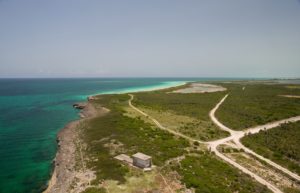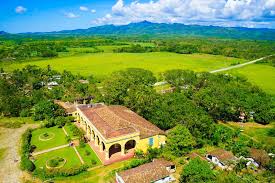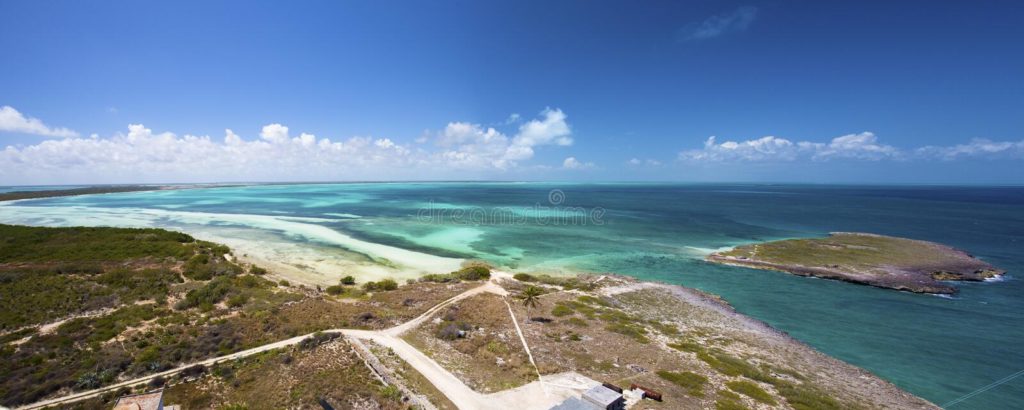CAYO PAREDON GRANDE, CUBA, DESCONOCIDO RINCON Y SU FARO INSIGNIA DIEGO VELAZQUEZ. PHOTOS.
Al este de Cayo Coco, un camino cruza hacia Cayo Romano (técnicamente Provincia de Camagüey) y gira hacia el norte hacia Cayo Paredón Grande y el Faro Diego Velázquez, un faro de 52 m que data de 1859.
EL CAYO PAREDÓN es una pequeña isla de aproximadamente 8,7 km2 en el archipiélago de Jardines del Rey al norte de la isla más grande de la región, Cayo Romano en Cuba. Esta isla, cuyo nombre completo es Cayo Paredón Grande, está ubicada en una zona protegida por el gobierno cubano. Está entre los cayos casi vírgenes en la costa norte del centro de Cuba.
Su nula infraestructura constructiva y el poco ajetreo humano lo convierten en un sitio de naturaleza pura, donde habitan unas cien especies del reino animal, entre ellas un gran grupo de aves migratorias y residentes.
Con hermosos paisajes tropicales y una rica biodiversidad, resalta por sus playas de origen coralino, entre las que sobresale la de Los Pinos por su finísima arena, sus aguas cálidas y transparentes, sus pocas pendientes submarinas y las corrientes suaves.
La cercanía de una barrera coralina de 400 kilómetros, considerada por los expertos como la segunda en importancia a nivel mundial -después de la australiana- añade un toque de distinción a la zona.
Según la leyenda, precisamente la exuberante naturaleza de cayos como Coco, Guillermo y Paredón Grande llevó al adelantado Diego Velázquez a nombrar ese lugar en homenaje al monarca español Fernando El Católico.
Entre las playas, existen varias como las llamadas las Coloradas, Jaula y de los Flamencos. El origen del nombre está en la presencia del ave conocida como Ibis Blanco -popularmente llamada pájaro Coco- que con sus brillantes colores aporta personalidad a la región.
Unas 200 especies de animales se localizan en el islote, entre las cuales destacan las aves y los reptiles como las iguanas y más de 360 especies de plantas, varias de ellas endémicas.
CAYO PAREDON Y SU FARO DIEGO VELAZQUEZ
Un sello distintivo del cayo es el faro Diego Velázquez, construido a mediado del siglo XX, cuyo nombre hace alusión al primer colonizador de Cuba.
Ubicado sobre un peñasco al norte de Cayo Paredón Grande la majestuosa obra de hierro fundido constituye un elemento significativo en la ingeniería cubana de alto valor. Sus orígenes se remontan a la primera mitad del siglo XIX cuando, en 1848, el Conde Cañongo propuso a la Real Junta de Fomento una moción para su construcción. Fue nombrado en homenaje al primer gobernador de Cuba.
La iluminación del faro ha evolucionado: primero utilizaba aceite, posteriormente petróleo y en la actualidad, electricidad. Sus destellos llegan hasta 18,9 millas de distancia. Con sus 159,7 pies de altura y desafiando el tiempo se mantiene como un centinela que protege la navegación de la corriente del Canal Viejo de Las Bahamas. Opciones: Baño en playa virgen de Cayo Paredón, observación de la naturaleza.
Con más de un siglo de existencia y castigado por los embates de huracanes, el centinela luminoso continúa emitiendo su destello para orientar a cientos de barcos que cruzan el canal Viejo de Bahamas, a tres millas de la costa norte de Ciego de Avila.
PAREDON GRANDE FLORA Y FAUNA
Paredón Grande debe su nombre a los altos farallones que bordean sus extremos y que a la vez funcionan como guardianes de las costas.
Numerosas colonias de flamencos y otras aves migratorias escogen a los mencionados islotes como sitio de escala obligada, situación que el hombre se ha encargado de preservar con la construcción de una infraestructura para respetar el entorno natural.
Una gran laguna natural prevalece en la parte sur y sirve de refugio durante la etapa invernal a variedades de plumíferos que llegan desde el norte de Estados Unidos y de Canadá.
En sus áridos terrenos crecen mangle rojo, hicacos, palma enana, cactus, yuraguano y lirios, mientras que en el mundo animal sobresalen garzas, alcatraces, palomas, rabihorcados y sevillas, entre otras especies y variedades.
Perteneciente a la Reserva de la Biosfera Buenavista, sobresalen en él los bosques de yuraguano, principalmente, en playa Los Pinos, como elementos naturales de alta significación.
Clasificado como muy frágil y estrecho, posee escasas formaciones vegetales, con predominio de matorral xeromorfo, poco llamativo, pero con una riqueza florística excepcional.
En su interior se localizan tres únicas especies de la flora y la fauna en la región: el cactus, de la familia Consolea Millspaughi; el Víreo de las Bahamas, y el Frailecillo Silbador (Pipig Plover),este último muy seguido mundialmente por ser una especie casi extinguida.
Arrecifes coralinos que aparecen en forma de crestas o promontorios, tapizando cantos y terrazas rocosas y en barras alternadas con canales de arena, son elementos que caracterizan las profundidades.
El coral pétreo Montastraea cavernosa es el más abundante, además de unas 30 especies de gorgonáceas e invertebrados conocidos comúnmente como ramajos.
CAYO PAREDON GRANDE, CUBA, UNKNOWN RINCON AND ITS INSIGNIA DIEGO VELAZQUEZ LIGHTHOUSE. PHOTOS.
East of Cayo Coco, a road crosses into Cayo Romano (technically Camagüey Province) and turns north towards Cayo Paredón Grande and the Diego Velázquez Lighthouse, a 52m lighthouse dating from 1859.
EL CAYO PAREDÓN is a small island of approximately 8.7 km2 in the Jardines del Rey archipelago north of the largest island in the region, Cayo Romano in Cuba. This island, whose full name is Cayo Paredón Grande, is located in an area protected by the Cuban government. It is among the almost virgin keys on the north coast of central Cuba.
Its zero construction infrastructure and little human activity make it a place of pure nature, where about a hundred species of the animal kingdom live, including a large group of migratory and resident birds.
With beautiful tropical landscapes and rich biodiversity, it stands out for its beaches of coral origin, among which Los Pinos stands out for its fine sand, its warm and transparent waters, its few underwater slopes, and its gentle currents.
The proximity of a 400-kilometer coral reef, considered by experts to be the second most important worldwide -after the Australian one- adds a touch of distinction to the area.
According to legend, precisely the exuberant nature of keys such as Coco, Guillermo, and Paredón Grande led Diego Velázquez to name this place in homage to the Spanish monarch Fernando El Católico.
Among the beaches, there are several such as those called Las Coloradas, Jaula and de los Flamencos. The origin of the name lies in the presence of the bird known as the White Ibis – popularly called the Coco bird – which with its bright colors brings personality to the region.
Some 200 species of animals are located on the islet, among which birds and reptiles such as iguanas and more than 360 species of plants stand out, several of them endemic.
CAYO PAREDON AND ITS DIEGO VELAZQUEZ LIGHTHOUSE
A hallmark of the key is the Diego Velázquez lighthouse, built in the mid-20th century, whose name alludes to the first colonizer of Cuba.
Located on a rock to the north of Cayo Paredón Grande, the majestic work of cast iron constitutes a significant element in high-value Cuban engineering. Its origins date back to the first half of the 19th century when, in 1848, Count Cañongo proposed a motion for its construction to the Royal Development Board. It was named in homage to the first governor of Cuba.
Lighthouse lighting has evolved: first it used oil, later oil, and now electricity. Its flashes reach up to 18.9 miles away. With its 159.7 feet high and defying time, it stands as a sentinel that protects the navigation of the current of the Old Channel of The Bahamas. Options: Bathing in the virgin beach of Cayo Paredón, observing nature.
With more than a century of existence and punished by the ravages of hurricanes, the luminous sentinel continues emitting its flash to guide hundreds of ships that cross the Old Bahamas channel, three miles from the north coast of Ciego de Avila.
PAREDON GRANDE FLORA AND FAUNA
Paredón Grande owes its name to the high cliffs that border its ends and that at the same time function as guardians of the coasts.
Numerous colonies of flamingos and other migratory birds choose the aforementioned islets as an obligatory stopover site, a situation that man has been in charge of preserving with the construction of an infrastructure to respect the natural environment.
A large natural lagoon prevails in the southern part and serves as a refuge during the winter stage for varieties of feathered birds that come from the northern United States and Canada.
In its arid lands grow red mangrove, hicacos, dwarf palm, cactus, yuraguano and lilies, while in the animal world herons, gannets, doves, oxtails and sevillas stand out, among other species and varieties.
Belonging to the Buenavista Biosphere Reserve, the yuraguano forests stand out, mainly on Los Pinos beach, as highly significant natural elements.
Classified as very fragile and narrow, it has few plant formations, with a predominance of xeromorphic scrub, inconspicuous, but with an exceptional richness of flora.
Inside it are located three unique species of flora and fauna in the region: the cactus, from the Consolea Millspaughi family; the Bahamas Vireo, and the Whistling Puffin (Pipig Plover), the latter very followed worldwide for being an almost extinct species.
Coral reefs that appear in the form of ridges or promontories, covering rocky edges and terraces and in bars alternated with sand channels, are elements that characterize the depths.
The stony coral Montastraea cavernosa is the most abundant, in addition to some 30 species of gorgons and invertebrates commonly known as ramajos.
Agencies/ Wiki/ Rad.Hab./Neisa Mesa/ Extractos/ Excerpts/ Internet Photos/ Arnoldo Varona/ www.TheCubanHistory.com
THE CUBAN HISTORY, HOLLYWOOD.



























